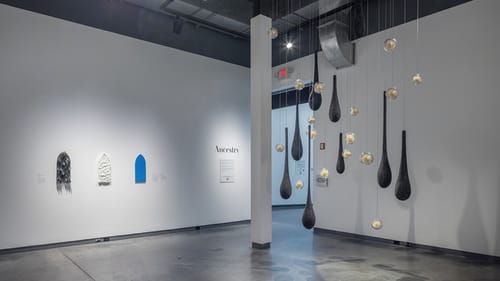Stay in the Loop
BSR publishes on a weekly schedule, with an email newsletter every Wednesday and Thursday morning. There’s no paywall, and subscribing is always free.
Stop taking glass for granted
The Delaware Contemporary presents Through a Glass, Darkly

Every day, we peer through glass to view the world around us, and we have come to take that substance for granted. But at the Delaware Contemporary, a bevy of artists who see glass as something else—transformative, mysterious, provocative, even frightening—gather for Through a Glass, Darkly, an interesting but wandering exhibition.
The museum generally mounts several concurrent shows, but here, six gallery spaces (over 6,000 square feet) are each focused on a different facet of the medium. Widely divergent, very current works are gathered under groupings called Body, Environment, Ancestry, End-of-Days, Perspective, and Systems. There are 37 artists on view, including four “anchor artists” each with several works in the show: Bohyun Yoon, Helen Lee, Kristen Neville Taylor, and David King.
In the lobby, before you enter the galleries (which can be viewed in any order) are glass constructions by Philadelphian Madeline Rile Smith. Her Instruction for Connection and Compromise (2021) is an arresting clear glass wind instrument for four simultaneous players who must all work together to make a sound. Smith will be on hand at the Friday, December 2 Art Loop open house to talk and demonstrate.
Lens, mosaic, mobile, and mirror
Works range from tiny to huge. The gallery titled Perspective illustrates this: Carolyn Spears’s 2021 Lens Study (memory and perception) is composed of more than two dozen small lenses that magnify or distort the surrounding environment, while Kate Clements’s Window to the World (2022) references the arts and crafts movement in a 10x12-foot mosaic-type installation with tiny shards of kiln-fired glass in elegant lattice and floral pattern reminiscent of wallpaper.
In the Ancestry gallery is a work by Lee, an “anchor artist.” Her poetic installation Implosive and Incendiary (2022) is an elegant construction composed of a dozen clear glass balls filled with matches and black tar pitch drops hanging from the ceiling that Lee says reference racial histories for immigrant Americans. And in Systems, there is another evocative installation: Irradiated Circuitry (2021) by Jessica Julius, a many-piece mobile of copper, wire, glass, and mirrors creating a chaotic network whose multiple references range from our data-driven world to a splatter of ink.
Conversely, the Environment gallery works overtly evoke the natural world. Daniel Cutrone winningly utilizes computer-aided design and computer-aided machining to create his elegant Honey Birds (2020) with small white 3D-printed birds made in a beehive pattern perched on glass and marble nests and twigs. Radically different are the small but powerful shadow-box constructions of Kimberly Thomas. Titled Cloud Riding Contraption #1 and The Legacy (both 2022), they forcefully confront our material and temporal world.

The gallery titled Body features several works by Yoon, another "anchor artist." It includes the mesmerizing Mirror Armor (2021), a powerful installation of plexiglass mirrors and video that emphasizes and distorts the artist’s body to explore how we are expected to move and what constitutes reality. This work was also seen internationally in Riga, Latvia, and Shanghai, China.
Favorite fragments
There is an excellent and helpful 22-page guide to the complex exhibition and its associated programs, which include glass-blowing demonstrations (November 4, 5, and 6) by the famed Corning Museum of Glass’s Mobile Hot Shop.
The exhibition’s exceptionally apt title is, of course, from the biblical New Testament—the Apostle Paul’s admonition that our vision is imperfect. Through A Glass, Darkly has three experienced curators: Kristin Deady, Jenna Lucente, and Alexander Rosenberg. Deady and Lucente (also a Delaware Contemporary studio artist) are both affiliated with New Jersey’s Salem Community College and its internationally recognized glass program; Rosenberg is a noted artist, educator, and writer based in Philadelphia and New York who has appeared on the Netflix series Blown Away.
This trio of viewpoints accounts for both the exhibition’s strengths and its weakness. Because of the curators’ expertise and hands-on experience, they have gathered a wide array of artists; not often would you find so much diverse work exploring one medium gathered in one place. Diversity of curatorial input is the exhibition’s strong point.
But this triumvirate means that there is no consistent point of curatorial view, something always helpful to navigating a show like this. Dividing the exhibition into six (albeit internally cogent) sections fragments the overall viewing experience. As illuminating as the individual works are, I was led in many divergent directions, feeling almost as though I had to pick my favorite gallery. And I did. You may find one too.
What, When, Where
Through a Glass, Darkly. Through December 31, 2022. Suggested donation of $12 ($6 for children). The Delaware Contemporary, 200 South Madison Street (on the Riverfront), Wilmington. (302) 656-6466 or decontemporary.org.
Masks are optional but recommended inside the museum.
Accessibility
The museum is wheelchair-accessible, with free parking and a barrier-free entrance.
Sign up for our newsletter
All of the week's new articles, all in one place. Sign up for the free weekly BSR newsletters, and don't miss a conversation.

 Gail Obenreder
Gail Obenreder